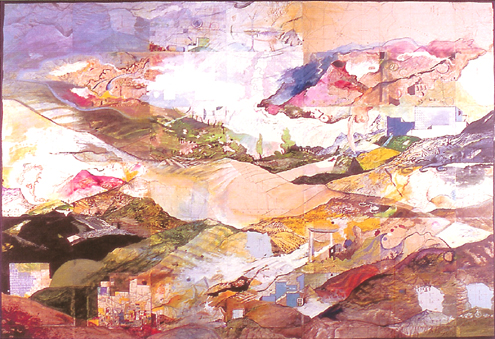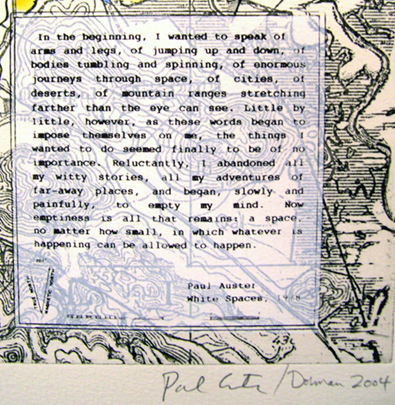Josh Dorman
Curated by Paul Auster
October 21st – November 27th, 2004
Opening Reception: Thursday, October 21st, 6-8p
Josh Dorman was born in Baltimore in 1966. He graduated Skidmore College in 1988, then received his MFA from Queens College in 1992. Dorman's work has been exhibited in solo shows at galleries including 55 Mercer in New York City and Galerie Francoise in Baltimore, and in various group shows, most recently at The Drawing Center and The National Academy Museum. His drawings and paintings have been reviewed in Modern Painters, Art in America, and The New Republic. He works in a studio in Long Island City and has been granted residencies at Yaddo and the Millay Colony. He has taught in and around New York, including Skidmore College, City University and Rider University. He lives in Windsor Terrace, Brooklyn.
Paul Auster's two most recent novels are The Book of Illusions (2002) and Oracle Night (2003). His Collected Poems were published earlier this year. He lives in Brooklyn.
ARTIST'S STATEMENT
I am not a landscape painter. My goal is not to depict the way light plays on treetops, but I do want to get inside to see the rings of the trees, explore the structure of the roots and branches, understand the bark. Lately, I've been using maps to find my way. I was seduced by these obsolete weathered pages---their elegant lines revealing eons of geological shift and erosion---all translated by human mind and hand. The risk I was taking and the implied violation inherent in putting my first marks on the antique paper was bracing. It brought drawing back into my paintings, erased the horizon line, and provided me with a ground on which to excavate and impose images. As if I am walking through nature with a magnifying glass and telescope, I find cells, mushrooms, thunderheads, pebbles, cliffs, continents.
I tilt these flattened lands into the frontal plan and then I seek routes and valleys back into space. I'm hoping for vertigo. But there is no one way to lose my balance. I follow a river with ink. I clog a harbor with oil paint. The name of a town or mountain might require something more literal - Rabbit Hills, Burning Spring. After the Fall of 2001, I found I needed to erect buildings out of the grid work of the maps. I could no longer avoid the human presence in my work or continue to invent a pastoral universe.
When I was eight years old, I'd lie on my stomach on my bedroom floor and draw with colored pencils in ring-bound sketchbooks. These drawings (now yellow with age) are full of monsters, winged beings, organic machines with gears and tendrils and bolts of electric current. Drawing on these old topographic maps with their sepia mazes returned these lost shapes and memories to me and provided me with a new framework for painting, a way to navigate space.
CURATOR'S STATEMENT
by Paul Auster
Four years ago, artist Josh Dorman walked into a used bookstore in Saratoga Springs and bought several topographical maps. It made perfect sense that he should have been attracted to these century-old projections of distant and unknown places. Dorman's recent work had been largely devoted to the rendering of imaginary landscapes, little dream worlds that combined representation and abstraction, the recognizable and almost recognizable in canvasses of exquisite refinement and beauty. Call them portraits of an inner homeland, a topos of the spirit. Now, confronted with these maps of real places, a new idea gradually caught hold of him. It took two full years before the impulse ripened into action-and then he took the plunge.
Working with a pen and colored ink, Dorman began inscribing his marks on the maps themselves, initiating an intense and passionate dialogue between the printed material and his own imagination. Inspired by the swirls and sinuous lines of valleys, by the oddly contorted shapes of mountains and rivers, even by the words denoting bays and estuaries and towns, Dorman let his hand go wherever it wanted to go, responding to these flattened-out ideograms by digging deep into his own unconscious. No plan, no agenda, no constraint. If there is a formal method underlying Dorman's art, it would be this: You find it in the act of doing it, and each time you do it, you discover something you hadn't known before.
The map pieces are tantalizing, elusive works. Though small in scale, they are difficult to describe, almost impossible to pin down in words, and yet they hold our attention in the same way that stories do. So much is going on in them that we feel compelled to look for a narrative, as if by "reading" the images before us we could finally grasp them in all their complexity. But the story I will read in one of these pictures is not the same story you will read. More than anything else, that singularity of response attests to the charm and power of these works.
On the one hand, they are exuberant, almost child-like in their energy. On the other hand, the dominant feeling they provoke in us is one of reflection, of meditation. There is no solution to the mystery. As Dorman put it in a recent letter to me: "Ultimately, I paint to find out why I have to paint…in order to see things that wouldn't exist if I didn't make them. But I feel satisfaction only when I am genuinely surprised by what happens. As Braque once said: 'There is only one thing in art of any value-that which cannot be explained.'"
View CATALOGUE







